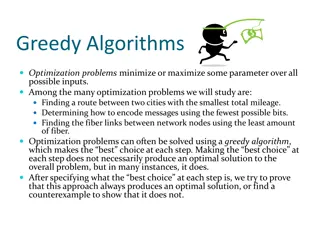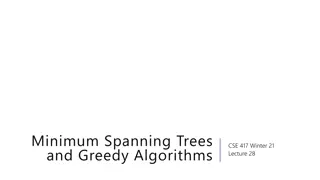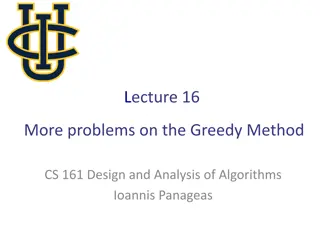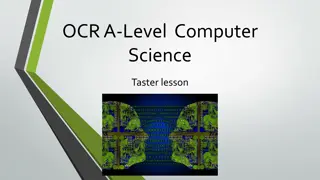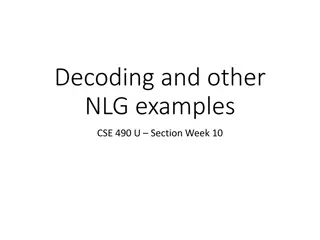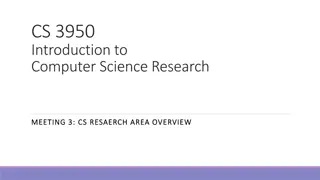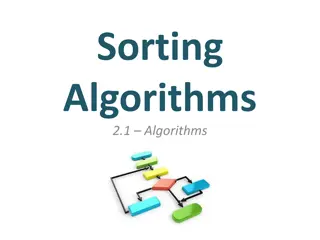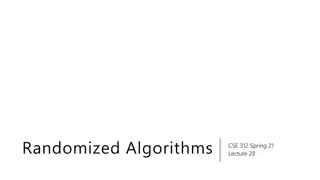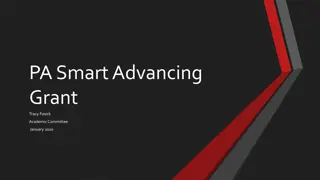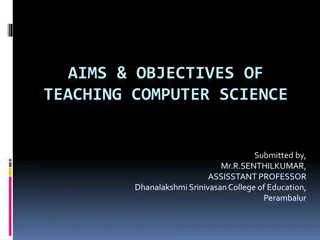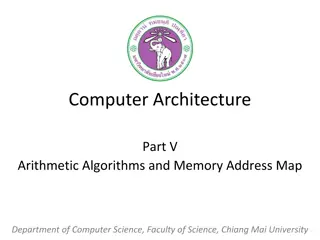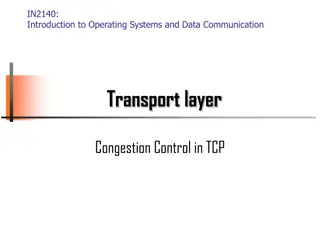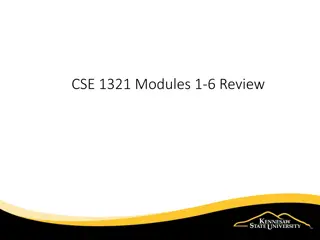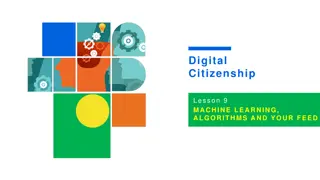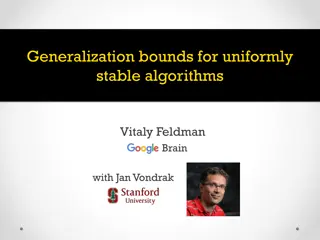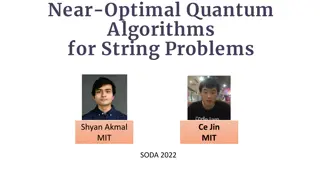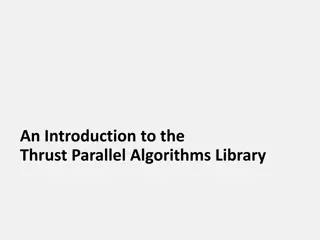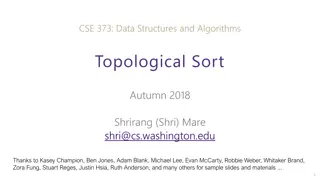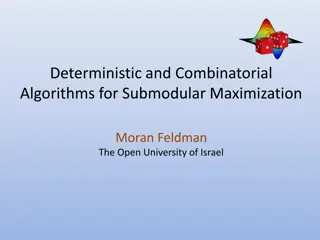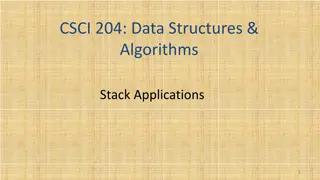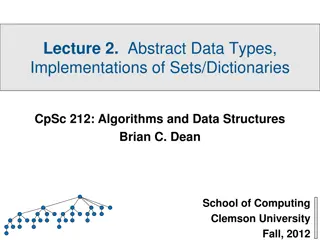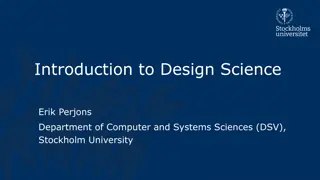Understanding Greedy Algorithms in Computer Science
Greedy Algorithms make decisions based on immediate rewards, prioritizing current benefits over future optimal solutions. This approach is efficient for certain problems, such as finding the best move in chess or solving the coins problem. Greedy algorithms offer simplicity and speed by selecting the option that seems best at each step, without considering all possible scenarios. The concept is illustrated through examples like finding the minimal number of coins to reach a specific value or constructing a minimum spanning tree in a graph. Explore the trade-offs and effectiveness of greedy methods in problem-solving.
Download Presentation

Please find below an Image/Link to download the presentation.
The content on the website is provided AS IS for your information and personal use only. It may not be sold, licensed, or shared on other websites without obtaining consent from the author. Download presentation by click this link. If you encounter any issues during the download, it is possible that the publisher has removed the file from their server.
E N D
Presentation Transcript
Greedy Algorithms Make choice based on immediate rewards rather than looking ahead to see the optimum In many cases this is effective as the look ahead variation can require exponential time as the number of possible factors combine Best way to get to a destination? Without other knowledge, going down the road that heads in the direction of the destination is probably a reasonable choice This is the greedy approach and can do well in some cases It also makes the decision much easier than considering all possible future alternatives May not be the optimal decision, in contrast to considering all possible alternatives and then subsequent alternatives, etc. CS 312 Greedy Algorithms 1
Next Move in Chess What move should you do next Could do move which leaves you in the best material position after one move, standard greedy approach Greedy since it takes best now without considering the ramifications of what could occur later Could do a 2nd order greedy approach Look two moves ahead More time consuming Better? Nth order greedy? until game decided No longer greedy since consider full situation Exponential time required CS 312 Greedy Algorithms 2
Coins Problem Given: An unbounded supply of coins of specific denominations An integer c Find: Minimal number of coins that add up to c What is your greedy algorithm? CS 312 Greedy Algorithms 3
Coins Algorithm Repeat until sum = c Add the largest coin which does not cause sum to exceed c Does this work and is it Optimal? Assume denominations are 50 , 20 , 3 , 2 Try it with goal of 75 , 60 Now assume denominations are 50 , 20 , 3 , 1 Greedy Philosophy Build up a solution piece by piece Always choose the next piece that offers the most obvious and immediate benefit Without violating given constraints CS 312 Greedy Algorithms 4
MST Minimum Spanning Tree Given a connected undirected graph we would like to find the cheapest connected version of that graph Remove all extra edges, leaving just enough to be connected (V- 1) it will be a tree Given G = (V, E), find the tree T = (V, E') where E' E which minimizes the sum of the edge lengths Not necessarily unique Many applications cheapest phone network, etc. CS 312 Greedy Algorithms 5
MST Minimum Spanning Tree What greedy algorithm might we use assuming we start with the entire graph 1 2 1 2 3 5 6 6 4 4 3 8 4 5 6 7 4 3 7 CS 312 Greedy Algorithms 6
MST Minimum Spanning Tree What greedy algorithm might we use assuming we start with the entire graph Iteratively take away the largest remaining edge in the graph which does not disconnect the graph Is it a greedy approach? Complexity? How do we prove if it works/optimal or not Counterexamples natural first attempt If no easily found counterexamples, we then seek a more formal proof 1 2 1 2 3 5 6 6 4 4 3 8 4 5 6 7 4 3 7 CS 312 Greedy Algorithms 7
Kruskal's Algorithm Sometimes greedy algorithms can also be optimal! Kruskal's is a simple greedy optimal algorithm for MST Start with an empty graph Repeatedly add the next smallest edge from E that does not produce a cycle 1. 2. How might we test for cycles and what would the complexity be? more efficient data structure? CS 312 Greedy Algorithms 8
Kruskal's Algorithm find(u) = find(v) if u and v are in the same set, which means they are in the same connected component Why not add edge {u,v} if both are in the same set? Represents nodes in disjoint sets makeset(u): create a singleton set containing just u find(u): to which set does u belong? union(u,v): merge the sets containing u and v 9
Kruskals Algorithm Make a disjoint set for each vertex 1 2 {1}{2}{3}{4}{5}{6}{7} 1 2 3 5 6 6 4 4 3 8 4 5 6 7 4 3 7 CS 312 Greedy Algorithms 10
Kruskals Algorithm Sort edges by weight 1 2 1: (1,2) 2: (2,3) 3: (4,5) 3: (6,7) 4: (1,4) 4: (2,5) 4: (4,7) 5: (3,5) {1}{2}{3}{4}{5}{6}{7} 1 2 3 5 6 6 4 4 3 8 4 5 6 7 4 3 7 CS 312 Greedy Algorithms 11
Kruskals Algorithm Add first edge to X if no cycle created 1 2 1: (1,2) 2: (2,3) 3: (4,5) 3: (6,7) 4: (1,4) 4: (2,5) 4: (4,7) 5: (3,5) {1}{2}{3}{4}{5}{6}{7} 1 2 3 5 6 6 4 4 3 8 4 5 6 7 4 3 7 CS 312 Greedy Algorithms 12
Kruskals Algorithm Merge vertices in added edges 1 2 1: (1,2) 2: (2,3) 3: (4,5) 3: (6,7) 4: (1,4) 4: (2,5) 4: (4,7) 5: (3,5) {1,2}{3}{4}{5}{6}{7} 1 2 3 5 6 6 4 4 3 8 4 5 6 7 4 3 7 CS 312 Greedy Algorithms 13
Kruskals Algorithm Process each edge in order 1 2 1: (1,2) 2: (2,3) 3: (4,5) 3: (6,7) 4: (1,4) 4: (2,5) 4: (4,7) 5: (3,5) {1,2}{3}{4}{5}{6}{7} {1,2,3}{4}{5}{6}{7} 1 2 3 5 6 6 4 4 3 8 4 5 6 7 4 3 7 CS 312 Greedy Algorithms 14
Kruskals Algorithm 1 2 1: (1,2) 2: (2,3) 3: (4,5) 3: (6,7) 4: (1,4) 4: (2,5) 4: (4,7) 5: (3,5) {1,2}{3}{4}{5}{6}{7} {1,2,3}{4}{5}{6}{7} {1,2,3}{4,5}{6}{7} 1 2 3 5 6 6 4 4 3 8 4 5 6 7 4 3 7 Note that each set is a connected component of G 15
Kruskals Algorithm 1 2 1: (1,2) 2: (2,3) 3: (4,5) 3: (6,7) 4: (1,4) 4: (2,5) 4: (4,7) 5: (3,5) {1,2}{3}{4}{5}{6}{7} {1,2,3}{4}{5}{6}{7} {1,2,3}{4,5}{6}{7} {1,2,3}{4,5}{6,7} 1 2 3 5 6 6 4 4 3 8 4 5 6 7 4 3 7 CS 312 Greedy Algorithms 16
Kruskals Algorithm 1 2 1: (1,2) 2: (2,3) 3: (4,5) 3: (6,7) 4: (1,4) 4: (2,5) 4: (4,7) 5: (3,5) {1,2}{3}{4}{5}{6}{7} {1,2,3}{4}{5}{6}{7} {1,2,3}{4,5}{6}{7} {1,2,3}{4,5}{6,7} {1,2,3,4,5}{6,7} 1 2 3 5 6 6 4 4 3 8 4 5 6 7 4 3 7 CS 312 Greedy Algorithms 17
Kruskals Algorithm Must join separate components 1 2 1: (1,2) 2: (2,3) 3: (4,5) 3: (6,7) 4: (1,4) 4: (2,5) 4: (4,7) 5: (3,5) {1,2}{3}{4}{5}{6}{7} {1,2,3}{4}{5}{6}{7} {1,2,3}{4,5}{6}{7} {1,2,3}{4,5}{6,7} {1,2,3,4,5}{6,7} rejected 1 2 3 5 6 6 4 4 3 8 4 5 6 7 4 3 7 CS 312 Greedy Algorithms 18
Kruskals Algorithm Done when all vertices in one set. Then they are all connected with exactly |V| - 1 edges. Book version just goes until all edges considered. 1 2 1: (1,2) 2: (2,3) 3: (4,5) 3: (6,7) 4: (1,4) 4: (2,5) 4: (4,7) 5: (3,5) {1,2}{3}{4}{5}{6}{7} {1,2,3}{4}{5}{6}{7} {1,2,3}{4,5}{6}{7} {1,2,3}{4,5}{6,7} {1,2,3,4,5}{6,7} rejected {1,2,3,4,5,6,7} done 1 2 3 5 6 6 4 4 3 8 4 5 6 7 4 3 7 CS 312 Greedy Algorithms 19
Kruskal's Algorithm Is it correct? We have created a tree since we added V-1 edges with no cycles But how do we know it is a minimal spanning tree (MST)? We have added the V-1 smallest possible edges that do not create cycles Thus, it seems intuitive that we have the smallest sum of edges and an MST But that is not a proof Review the proof in the book CS 312 Greedy Algorithms 20
Kruskal's Algorithm: Inductive Proof Theorem: Kruskal s Algorithm finds a minimum spanning tree Basis: Xo = and G is connected so a solution must exist Is this a correct partial solution? Assumption: At any moment edges Xt are part of an MST for G Inductive step is the Cut Property Cut Property: Assume edges X are part of an MST for G=(V,E). Pick any subset S for which X does not cross between S and V-S, and let e be the lightest edge across this partition. Then X {e} is part of some MST. S V - S e X CS 312 Greedy Algorithms 21
Cut Property: Assume edges X are part of an MST for G=(V,E). Pick any subset S for which X does not cross between S and V-S, and let e be the lightest edge across this partition. Then X {e} is part of some MST. Why? 1. Assume edges X are part of a partial MST T (Inductive hypothesis) 2. If e is a part of T then done, so consider case where e is not part of T 3. Now add e to T, creating a cycle, meaning there must be another edge e' across the cut (S, V-S) (note that weight(e') weight(e)) 4. Create T' by replacing e' with e: T' = T {e} {e'} 5. T' is a tree since it is connected and still has |V|-1 edges 6. T' is an MST since: 1. weight(T') = weight(T) + w(e) w(e') 2. both e and e' cross the cut (S, V-S) 3. by cut property e was the lightest edge across the cut 4. Therefore, w(e') = w(e) and T' is an MST Thus, any (and only a) lightest edge across a cut will lead to an MST CS 312 Greedy Algorithms 22
Cut Property Which edge is e'? CS 312 Greedy Algorithms 23
Kruskal's Algorithm Implementation Data structure represents the state as a collection of disjoint sets where each set represents a connected component (sub-tree) of G CS 312 Greedy Algorithms 24
Directed Tree Representation of Disjoint Sets Nodes are stored in an array (fast access) and have a pointer and a rank value (x) is a pointer to parent if (x) points to itself it is the root/name of the disjoint set rank(x) is the height of the sub-tree rooted at node x makeset is O(1) find(x) returns the unique root/name of the set union(x,y) merges sets to which x and y belong and keeps the tree balanced so that the maximum depth of the tree representing the disjoint set is log|V| find and union complexity? CS 312 Greedy Algorithms 25
Node (x) Rank Node (x) Rank A D 0 A D 0 B E 0 B E 0 C F 0 C F 0 D D 1 D D 2 E E 1 E D 1 F F 1 F F 1 CS 312 Greedy Algorithms 26 G G 0 G F 0
**Challenge Question** Kruskal's Algorithm 1. Given top image, show the new image and array representation after union(B, G) 2. What is the time and space complexity for Kruskal's algorithm with this data structure? CS 312 Greedy Algorithms 27
Kruskal Algorithm Complexity O(|E|log|V|) for initially sorting the edges Sort is actually O(|E|log|E|) Note that for a dense graph |E| |V|2 But remember that logn2 = 2logn so they only differ by a constant factor and thus (|E|log|V|) = (|E|log|E|) O(|V|) for the initial makesets since each is O(1) find(u): log|V| 2|E| times: O(|E|log|V|) union(u,v): log|V| |V|-1 times (why?) O(|V|log|V|) Total complexity is O(|E|log|V| + |V| makeset_complexity + |E| find_complexity + |V| union_complexity) Total complexity: O(|E|log|V|) CS 312 Greedy Algorithms 28
Could compress depth during find. How? Could do compression if we plan on using data structure a lot Over time find would then have amortized O(1) complexity CS 312 Greedy Algorithms 29
Prim's Algorithm Prim's algorithm grows one SCC (X and S) as a single tree X (edges) and S (vertices) are the sets of intermediate edges and vertices in this partial MST On each iteration, X grows by one edge, and S by one vertex The smallest edge between a vertex in S and a vertex outside S (V - S) All vertices S and V-1 edges must eventually move into S and X Cannot create a cycle since new vertex not currently in S and we never add a new edge between two nodes already in S What is an efficient data structure to retrieve that edge? The algorithm is basically Dijkstra's algorithm except that the PQ key value for each node outside S is its smallest edge into S CS 312 Greedy Algorithms 30
Prim's Algorithm An Intuitive Version Consider each node as wanting to get into club S All nodes must join the club before we finish Each non-member (V-S) has an entry key which is the smallest edge length from itself to any current member of the club At each iteration the non-member with the smallest key joins the club Whenever a new member joins the club, all non-members with edges to the new member have their key updated if their edge to the new member is smaller than their current smallest edge into the club CS 312 Greedy Algorithms 31
Prim's Algorithm Decreasekey does not update path length, but updates the key with the decreased edge cost between v and z Almost the same as Dijkstra's Algorithm, same complexity values CS 312 Greedy Algorithms 32
Prims Algorithm Choose arbitrary starting vertex, set to 0 and deletemin 1 2 S = {5} 1 2 3 1: 2: 3: 4: 5: 0 6: 7: 5 6 6 4 4 3 8 4 5 6 8 4 3 7 CS 312 Greedy Algorithms 33
Prims Algorithm Choose arbitrary starting vertex, set to 0 and deletemin 1 2 S = {5} 1 2 3 1: 2: 4 3: 5 4: 3 6: 8 7: 8 5 6 6 4 4 3 8 4 5 6 8 4 3 7 CS 312 Greedy Algorithms 34
Prims Algorithm deletemin returns node with shortest edge into S 1 2 S = {5} S = {4,5} X: 1 2 3 1: 2: 4 3: 5 4: 3 6: 8 7: 8 {4,5} 5 6 6 4 4 3 8 4 5 6 8 4 3 7 CS 312 Greedy Algorithms 35
Prims Algorithm Don t actually store S or X. Final S is all V and we get MST using prevs which are fixed once node dequeued. PQ contains nodes not yet in MST (V S) 1 2 S = {5} S = {4,5} X: 1 2 3 1: 2: 4 3: 5 4: 3 6: 8 7: 8 {4,5} 5 6 6 4 4 3 8 4 5 6 8 4 3 7 CS 312 Greedy Algorithms 36
Prims Algorithm Update then decreases keys in PQ (shortest edge into S) where possible, based on new node just added to S 1 2 S = {5} S = {4,5} X: 1 2 3 1: 4 2: 4 3: 5 6: 8 7: 4 {4,5} 5 6 6 4 4 3 8 4 5 6 8 4 3 7 CS 312 Greedy Algorithms 37
Prims Algorithm Repeat until PQ is empty 1 2 S = {5} S = {4,5} S = {1,4,5} X: 1 2 3 2: 1 3: 5 6: 8 7: 4 {4,5} {1,4} 5 6 6 4 4 3 8 4 5 6 8 4 3 7 CS 312 Greedy Algorithms 38
Prims Algorithm Repeat until PQ is empty 1 2 S = {5} S = {4,5} S = {1,4,5} S = {1,2,4,5} X: 1 2 3 3: 2 6: 8 7: 4 {4,5} {1,4} {1,2} 5 6 6 4 4 3 8 4 5 6 8 4 3 7 CS 312 Greedy Algorithms 39
Prims Algorithm Repeat until PQ is empty 1 2 S = {5} S = {4,5} S = {1,4,5} S = {1,2,4,5} S = {1,2,3,4,5} X: 1 2 3 6: 6 7: 4 {4,5} {1,4} {1,2} {2,3} 5 6 6 4 4 3 8 4 5 6 8 4 3 7 CS 312 Greedy Algorithms 40
Prims Algorithm Repeat until PQ is empty 1 2 S = {5} S = {4,5} S = {1,4,5} S = {1,2,4,5} S = {1,2,3,4,5} S = {1,2,3,4,5,7} X: 1 2 3 6: 3 {4,5} {1,4} {1,2} {2,3} {4,7} 5 6 6 4 4 3 8 4 5 6 8 4 3 7 CS 312 Greedy Algorithms 41
Prims Algorithm Repeat until PQ is empty 1 2 S = {5} S = {4,5} S = {1,4,5} S = {1,2,4,5} S = {1,2,3,4,5} S = {1,2,3,4,5,7} S = {1,2,3,4,5,6,7} X: 1 2 3 {4,5} {1,4} {1,2} {2,3} {4,7} {6,7} 5 6 6 4 4 3 8 4 5 6 8 4 3 7 CS 312 Greedy Algorithms 42
Complexity Dense Graph: |E| = O(|V|2) Kruskal s: Prim s (w/ Array PQ): Prim s (w/ Binary Heap PQ): (|E| log |V|) = (|V|2log |V|) (|V|2) (|E| log |V|) = (|V|2log |V|) Sparse Graph: |E| = O(|V|) Kruskal s: Prim s (w/ Array PQ): Prim s (w/ Binary Heap PQ): (|E| log |V|) = (|V| log |V|) (|V|2) (|E| log |V|) = (|V| log |V|) Punch-lines Prim s with Array PQ is best for a dense graph Kruskal s with sets OR Prim s with Heap PQ are both about the same for sparser graphs Kruskal s gives more control when choosing between edges with ties in cost and some consider Kruskal s as easier to implement CS 312 Greedy Algorithms 43
Huffman Encoding Commonly used algorithm Example: MP3 audio compression which works as follows Digitize the analog signal by sampling at regular intervals Yields real numbers s1, s2, , sT High fidelity is 44,100 samples per second Thus a 50 minute symphony would have T= 50 60 44,100 130 million samples Quantize each sample stinto a finite alphabet These are called codewords or symbols e.g. Quantize into 16 bit numbers Sufficient that close codewords are indistinguishable to human ear Encode the quantized values into binary numbers Huffman coding (compression) can give savings in this step CS 312 Greedy Algorithms 44
Huffman Encoding CS 312 Greedy Algorithms 45
Huffman Encoding Assume an example of 130 million samples, and that the alphabet has 4 codewords: A, B, C, D Thus all measurements are quantized into one of 4 values Encode these into binary A: 00 B: 01 C: 10 D: 11 Total memory would be 260 million bits (2 bits/sample) Can we do better? CS 312 Greedy Algorithms 46
Huffman Encoding Consider the frequency (count) of the symbols: A, B, C, D A: 70 million B: 3 million C: 20 million D: 37 million Could use a variable length encoding where more common codewords are represented with less bits? A: 0 B: 001 C: 01 D: 10 Total number of bits would now be less due to frequency of A However, how would you distinguish AC from B? CS 312 Greedy Algorithms 47
Prefix-Free Property Prefix-Free Property: A binary encoding such that no codeword can be a prefix of another codeword Any full binary tree (all nodes have 0 or two children) with the #leafs equal to the #codewords will always give a valid prefix free encoding Any codeword can arbitrarily be at any leaf, but we want more frequent codewords higher in the tree Encoding below allows us to store our example with 213 Mbits 17% improvement But how do we find an optimal encoding tree? Simple Alg? CS 312 Greedy Algorithms 48
Optimal Encoding Tree Assume frequency (count) of codewords are f1, f2, , f| | |G| cost(tree) = depth_in_tree(si) fi i=1 Treecost = 70 1 + 37 2 + 3 3 + 20 3 = 213 Rather than 2 bits per sample we have 1*70/130 + 2*(37/130) + 3*((20 + 3)/130) = average 1.64 bits per sample CS 312 Greedy Algorithms 49
Huffman Algorithm Greedy constructive algorithm Repeat until all codewords are used Pull the two codewords with the smallest fi and fj off the unordered list of frequencies Make them children of a new node with frequency fi + fj Insert fi + fj into the list of frequencies What data structure? Tree must have exactly 2n-1 nodes; n leafs and n-1 internal nodes CS 312 Greedy Algorithms 50


